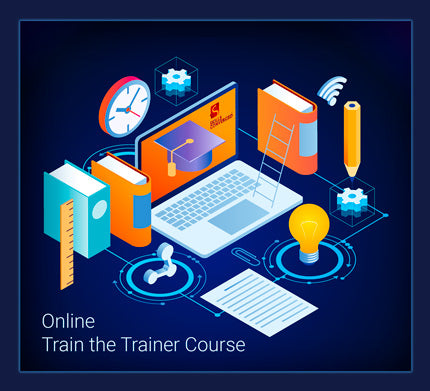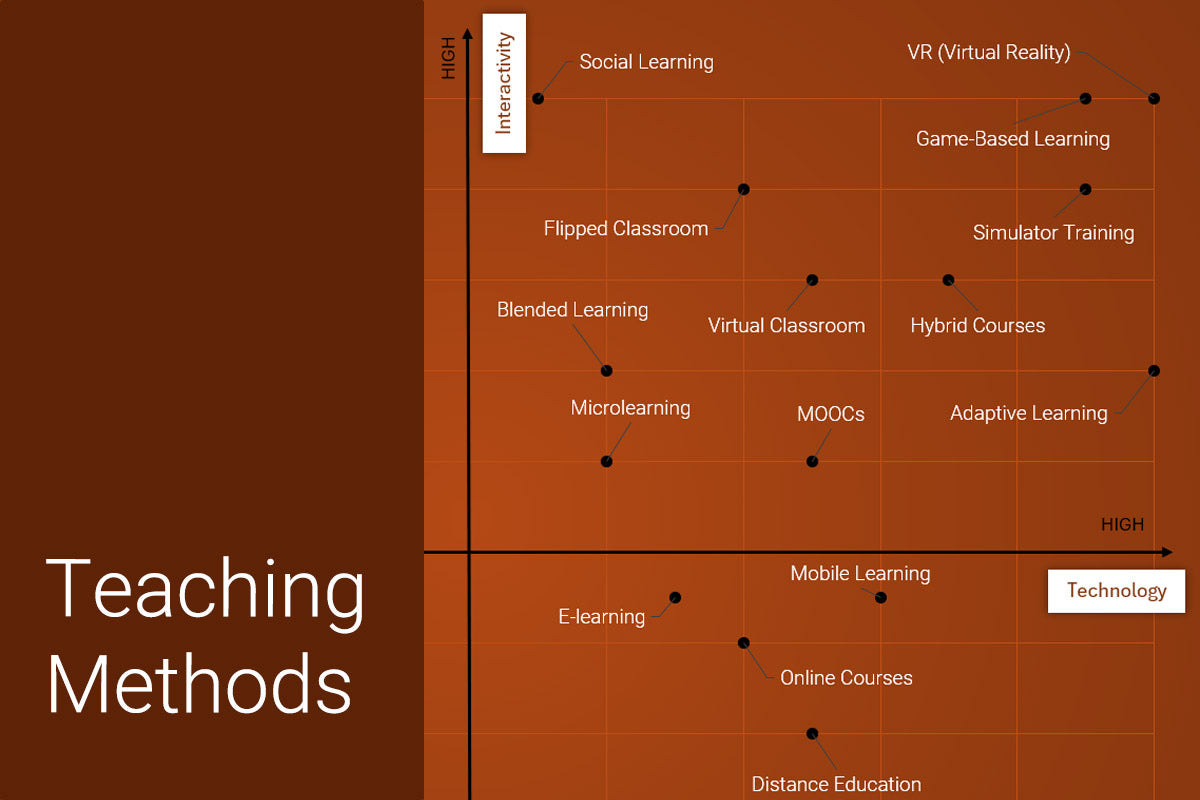What keeps people motivated? What does it take to motivate your students? What can you do to encourage your students to actually use and apply what they have learned in your course? How can you help them gain a skill and, crucially, keep the skill well after the course?
In this guide, I will aim to answer these questions and give you a series of easy-to-follow strategies that you can apply to your own training courses.
A Typical Training Scenario
Before diving in and focusing on how to motivate others, let’s just examine this by analysing your own behaviour as a student in the past.
Let’s start with when you first became interested in a topic and decided to spend more time on it. May be it was learning to make sculptures, or to code, or to render a scene in 3D graphics software.
After your initial interest, you start researching the subject. You conduct some online searches, find some free tutorials, read some blogs, buy some books and watch some videos to get a feel for the domain. You are now even more convinced that this is great fun and you want to take it further. This is when you start seriously considering enrolling into a course, whether an online course or an interactive one.

Let’s say you book a day-long course on how to paint in oil. The course is a success. You learn a lot and interact with other students who have similar interests and are just as curious and excited as you about this field. You feel quite motivated and excited about the oil painting and cannot wait to start working on new painting projects and utilise what you have learned.
So far so good.
Just after the course, you allocate some time and spend a couple of hours painting. You like the process but as the session progresses you also feel a bit frustrated. You cannot create what you have in mind and is off putting. You know you just started and you need to practice a lot more, but still, that doesn’t stop you from thinking that you really need to learn a great deal more before you can produce anything decent, let aside something great.
You go back to work and life goes on. You promise yourself that next weekend, you will do some more painting.
A week has gone; with all the job and life distractions, the painting course already feels like a distant memory. The weekend comes and you realise you have a series of errands to run. Somehow you don’t get a chance to paint since you feel you want to allocate a few hours for it, not just half an hour here and there.
Another week goes by. Weekend comes but somehow you don’t feel as enthusiastic as you were when you attended the course. What is happening? Why are you procrastinating?
Is there something that can be done about this?
I want you to replace the oil painting with a course you attended in the past that led to a similar scenario shown above. Then examine your own feelings and reasoning when it was time to apply your new learned skills:
- What did you find difficult or uninteresting?
- What made you let go of the field?
- Did you feel guilty for not spending enough time on the topic, and yet you left it unexplored?
- Do you feel your initial interest was unjustified and you got carried away exploring the topic; or that you liked the topic enough but life got in the way of exploring it deeply?
What Can you Learn as a Trainer?
Now, let’s step out of the role of a student and focus on being a trainer. We want to know what can be done to keep students motivated after attending a course. What techniques can you use to help them avoid the above scenario.
Answering such questions is certainly not straight forward. Motivation has always been an important topic in educational psychology and adult training. By putting ourselves in the position of students, we can discover strategies that help address motivation.
Let’s explore student motivation based on the underlying issues. Once an issue is identified we can then perform the following three tasks:
- We can analyse why students lose motivation.
- Based on this analysis we can formulate actions that help students to motivate themselves.
- Armed with these actions, we can come up with a series of strategies that can help students stay motivated.
Let’s explore these issues one by one and see what actions and strategies we can derive from them.
Issue #1: You Don’t Know Exactly What You Need to Do
Issue #2: A Habit Is Not Formed
Issue #3: You Don’t Know What You Like
Issue #4: You Don’t Plan Based on Your Priorities
Issue #1: You Don’t Know Exactly What You Need to Do
As a student, once you are excited about something, your initial interest will get you to read about it, look it up, talk about it and do some experiments. The problem is that after a few days, you may run out of these initial actions you set out to do.
This can then lead to lack of motivation. If you don’t know what exactly you need to do next, you are unlikely to do anything and as time goes by, you will increasingly feel more resistance to get back to the topic.
How Can You Motivate Yourself as a Student?
To keep yourself motivated after attending a course, a good strategy is to engineer an environment where you can immerse yourself in this new area that you got excited about. This gives you more chances of actually doing something and remaining motivated.
For example, you might have come across a beautiful oil painting and got excited that perhaps you can give oil painting a try. You read about it, look at some paintings and watch some videos online. It looks like fun playing with colour and paint. You decide to enrol yourself into a weekly evening course on oil painting.
To stay motivated and continue in this new field, you must keep your momentum and focus on actions.
Here are some examples for the painting scenario:
You investigate to see what the local art galleries are showcasing. You then plan to visit various interesting exhibitions. You get inspired by the art at display in these exhibitions. This energises you to create your own art.
The next day, you decide to pop into a bookshop during your lunch break. You explore the section on art and painting and end up buying a fascinating book on painting portraits, telling you what to do step by step.
You cannot wait to read it, so you start reading it on the train ride back home that same day. By weekend, you are half way through the book. You have now learned about the right kind of brushes, paints and palette knifes.
On Sunday, you go online and order some of the tools recommended by the book. The following week, you focus on your day job but continue reading the rest of the art book.
In a few days, you receive your order by post. You open the box with a feeling not indifferent from when you received a new toy as a child. You cannot wait to try out all the new art tools you got. When the weekend comes, no one can stop you from painting!
The week after, you chat with your family, friends and colleagues about your experience over the weekend and your new found hobby. You excitedly tell them how wonderful (or wonderfully hard) it is to learn painting.
Your motivation is high and through constant persistence stays high.
You are already thinking of attending another course, watching online videos, visiting your local art shop, etc. In short, you are immersed in the experience.
To stay motivated you focus on actions, persistence and focused determination (read our motivation book for a whole lot more on this topic)(Skills Converged 2015).
Just keep going. Each action helps you remain motivated and maintain momentum, leading you to the next action.
"Patience, persistence and perspiration make an unbeatable combination for success."Napoleon Hill
As a Trainer, How Can You Motivate Your Students?
Just as you can see from the analysis above, the key is to focus on actions and immersion. As a trainer you can facilitate this by giving students certain tasks. Space these tasks apart to keep the students immersed in the topic over a period of time. As they hit each of your designated tasks, it can lead them to the next series of actions which can help them stay on topic by intrinsic motivation.
You should plan these actions based on the topic of your course. Here are some examples:
- Give students assignments
- Refer them to exciting new books
- Get them to do group projects
- Offer them a chance to interact with you in a month time
- Ask them to send you pictures of what they have created and receive feedback
- Create a social media group for the students and get them to share their achievements
- Ask them to video themselves while working and self-coach
- Refer them to clubs and meet up groups that meet periodically. Attending such groups allows the students to network with other locals who have similar interests. This in turn helps them get motivated or find out where to obtain more resources and become aware of what is available in their local environment (like tool shops, clubs, groups, courses, etc.).
- Send an email to your students to keep them informed of the latest developments and any related courses or resources they can use, whether these courses are run by you or by others.
Issue #2: A Habit Is Not Formed
Continuing with the example, you got excited about oil painting and started on a new adventure. This new activity now sits next to all other commitments and habits. Until you turn learning about this new field into a new habit where you automatically feel you want to spend time on, you will have to consciously put effort into it.
This conscious effort can be taxing.
Let’s see what happens if you don’t form a habit. Initially, the task is hard and the results you produce are most probably poor. You are not skilled enough yet but you begin to understand what is required to improve. For example, in oil painting, your sense of aesthetics develops much faster than your skill of painting. So it becomes easier for you to see your faults and what is wrong with your painting but you are not skilled enough yet to do something about it. This is frustrating.
Conscious effort to persevere on something can get you only so far since it requires a lot of psyching up to start various tasks and experiments. You may feel that you are up against a ‘procrastination wall’.
With this kind of resistance, you fall back to your old routine and forget exploring this new field. Soon, it will only be a memory…
For a great book on the subject of procrastination and how to handle resistance to doing tasks, read “The War of Art” by Steven Pressfield (Pressfield 2012).
How Can You Motivate Yourself?
Focus on turning this new activity into a habit. To form a habit, focus on the habit loop. According to Charles Duhigg, a habit loop consists of three components: a cue, a routine and a reward (Duhigg 2014).
For example, you may dedicate a room in your house as your studio. Now, if every time you enter the room, you put an apron on and setup your easel and brushes, it acts as the cue.
The cue can then trigger a routine that you have established by having gone over this exact process over and over again. The routine helps you get into the motion of painting. By the time you have set yourself up, putting some paint on the canvas is a natural consequence. There is nothing to procrastinate over here.
Off you go…
After a couple of hours, you have painted something. Each time you will produce a work better than you have done before and your progression can become your reward. You may explicitly reward yourself too for the work you have put in so that you reinforce your habit loop: you have done the work, you can now go and buy that expensive brush you saw in the art shop the other day!
As a Trainer, How Can You Motivate Others?
Help your students develop a habit to engage in experimentation related to your course. Consider the following strategies for each component of the habit loop:
Cue
- Offer your course on a regular basis, say weekly, preferably at exactly the same time.
- Present your course in the same location with the same familiar tools, equipment, software and room configuration. You want to associate the place with the subject. Change of environment mid-session can break the habit loop.
- Assign exciting homework, exercises, experiments, research, etc. to encourage students to engage in the activity outside of the course environment. Your aim is to help them establish a routine by themselves in their own environment. The cue for them would then be to enter their already prepared environment and learn the new field. They may not have created this environment on their own without your specific assignments and projects.
Routine
- Design exercises that can be turned into an easily followed recipe or walkthrough. The aim is to help students practice such exercises repeatedly until they can master a task.
- Get them to practice these tasks in your periodic course in exactly the same way over and over again to establish a routine. The consistency and similarity of the exercises can help memorisation and ultimately becomes a routine.
- Refer students to places where they can obtain the right tools at affordable prices. Lack of tools is a great barrier; so is spending a lot of money on a field they are not yet sure they want to spend time on.
- Get students to start engaging in activities in parallel with your course, so that once the course is finished they can easily continue with what they have already setup and get into the routine.
Reward
- Praise the students. A simple honest public praise from you for a task well done can go a long way in motivating them.
- Reward students for their achievement. Don’t share or suggest what the reward is beforehand. Just reward students after they have succeeded in a task. A reward should not be expected as it will lose its value; rewards should be given based on achievement.
- Don’t assume that if someone is not getting it yet, then this field is not for them. Give them time. People learn at different rates and have different learning styles. If you believe they are not good enough, it can come across unconsciously and they can pick it up. Unfortunately many trainers fall for this. They focus more on promising students and praise them in a way that suggests others are hopeless! This will demotivate weaker students.
Issue #3: You Don’t Know What You Like
Most of the time, lack of motivation happens when you are not excited about something. You are apathetic about the subject. This often happens when you don’t know much about a given topic. You may then conclude that this topic is not for you when in reality you just didn’t give it a chance.
How Can You Motivate Yourself?
Quite often, as you gain knowledge about a domain, your excitement rises. So the first step in tackling apathy and laziness is to engage in reading, research, exercises and experimentation. You just have to try it for long enough. It’s really that simple.
As a Trainer, How Can You Motivate Others?
Encourage your students to follow what I call the 10-Minute Rule:
The 10-Minute Rule
Promise yourself that you are only going to engage in the learning activity for 10 minutes.
Doesn’t sound like much really. What is 10 minutes? It is over before you know. Students cannot come up with any excuse to avoid a task so short. Spending ten minutes on anything doesn’t require justification.
However, once they get going, the students often get carried away and spend more than ten minutes on the task. They break through the procrastination and laziness barrier and got themselves involved in the learning activity.
In the next session of your course, ask students to share what they liked. These discussions are incredibly valuable in several ways:
1. They Commit to Their Interests
Each student can self-analyse and then express publicly what they liked. This is a great reinforcement which will help them stay focused and motivated in the next round of activities. Now that they have told others they like X, they must engage in X some more.
2. They Learn What Others Liked
They get to see what areas other students liked. They can come across something they don’t know about. Or they can connect with others who liked similar aspects of the field and through mutual interest become even more motivated to learn.
3. You Learn What They Liked
Now that you know what interested them, you can feed students more content and exercises to further boost their enthusiasm. You can guide them to find more relevant information or assign challenging exercises that they would find interesting. The worst thing you can do is to stick to your own predefined rigid syllabus, irrespective of their new found interests.
Issue #4: You Don’t Plan Based on Your Priorities
In the hectic world of 21st century, there is so much going on that if you have other pressing issues, you may not feel motivated enough to follow up with a learning activity.
If you have 20 things going on, you cannot be hard on yourself that you are not pursuing yet another area. With all the stuff we are engaged in, there is always plenty more things you can get excited about that you don’t have time to attend to.
This means that you may initially get excited about a new field, learn about it for a while but then let it drift as you pursue other areas.
How Can You Motivate Yourself?
It all comes down to priorities. There is always a bunch of stuff you could spend your time on including the new learning activity; prioritisation makes it clear to yourself where you need to spend your time on. It prevents you from drifting away to other tasks or procrastinating.
As a Trainer, How Can You Motivate Others?
Ensure your students know how important and relevant this new topic is to their lives. If the new learning activity is related to their jobs, emphasise the benefits they obtain by learning it. Let them explore this and put it in their own terms how the new skills will help them in their jobs. Establish the need before you teach and at the end reinforce learning by relating what they’ve learned to their everyday life and job.
There is no magic trick to motivating students. You need to create the environment for them, help them see what they really want, allow them to create new habits and encourage them to decide on priority so they can master the skill.
References
Duhigg, C. (2014) “Power of Habit: Why We Do What We Do in Life and Business”, Random House Trade Paperbacks, ISBN: 978-0812981605
Pressfield, S. (2012) “The War of Art: Break Through the Blocks and Win Your Inner Creative Battles”, Black Irish Entertainment LLC, ISBN: 978-1936891023
Skills Converged (2015) “Focused Determination: How to Engineer Your Life to Maximise Your Happiness”, CreateSpace Independent Publishing Platform, ISB: 978-1511730099

About the Author
Dr Ethan Honary is the founder of Skills Converged Ltd. A training consultant, researcher, author and designer with an aim to help trainers worldwide to improve training delivery and course design.
Table of Contents
What Can you Learn as a Trainer?
Issue #1: You Don’t Know Exactly What You Need to Do
Issue #2: A Habit Is Not Formed
Issue #3: You Don’t Know What You Like
Issue #4: You Don’t Plan Based on Your Priorities
Course Design Strategy
Available as paperback and ebook
Online Train the Trainer Course:
Core Skills
Learn How to Become the Best Trainer in Your Field
Train The Trainer Book
Available as paperback and ebook
Explore Topics
Longform Train the Trainer Guides
All In-Depth Articles
CPD Accredited
Online Train the Trainer Course: Core Skills
Learn How to Become the Best Trainer in Your Field
Full Course Details
How to Reference This Article
Honary, E. (2020) "4 Powerful Strategies to Motivate Your Students", Skills Converged. Retrieved from: https://www.skillsconverged.com/blogs/train-the-trainer/powerful-strategies-to-motivate-students















1 comment
Nwafor okechukwu Raphael
I need training videos
Leave a comment
All comments are moderated before being published.
This site is protected by hCaptcha and the hCaptcha Privacy Policy and Terms of Service apply.